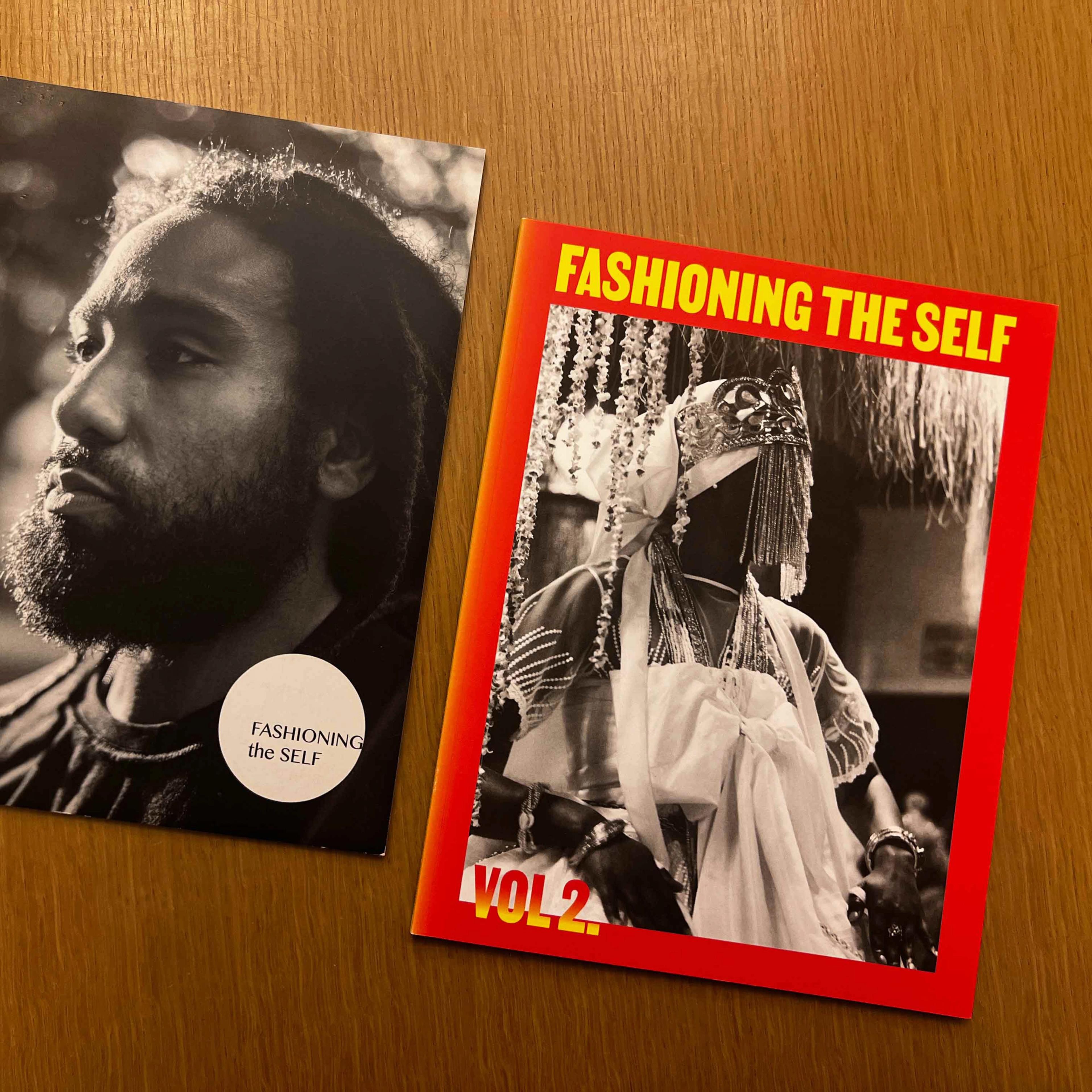The Costume Institute Library has a longstanding practice of collecting materials representing the global history of fashion. We are continuously focused on helping researchers discover emerging designers and artists who are not yet widely known, and we remain mindful of this challenge as it evolves. During the COVID-19 pandemic, inspired by all the “listicles” highlighting BIPOC creators that were circulating on social media at that time, the informative subject guides by our fellow library institutions at the Fashion Institute of Technology and Kent State University, as well as Kimberly Jenkins’s pioneering Fashion and Race Database, Costume Institute staff began tagging relevant library records with the keyword “Fashion DEIA.” This searchable term appears in our online catalog, Watsonline. By implementing small but impactful changes, we were able to help users discover new creatives in our library holdings and art collections.
In addition to keyword tagging, we enhanced our library catalog records to improve access to information about underrepresented designers. For example, we added detailed information such as a table of contents, designer name indexes, and publisher summaries to help users easily identify relevant resources. Threads of Time, The Fabric of History (2002), which profiles African American dressmakers from 1850 to the present, includes a wealth of names, many of them lesser-known. By making these names searchable in our catalog, we’ve made it easier for researchers to find specific designers and uncover valuable, often overlooked contributions to fashion history.
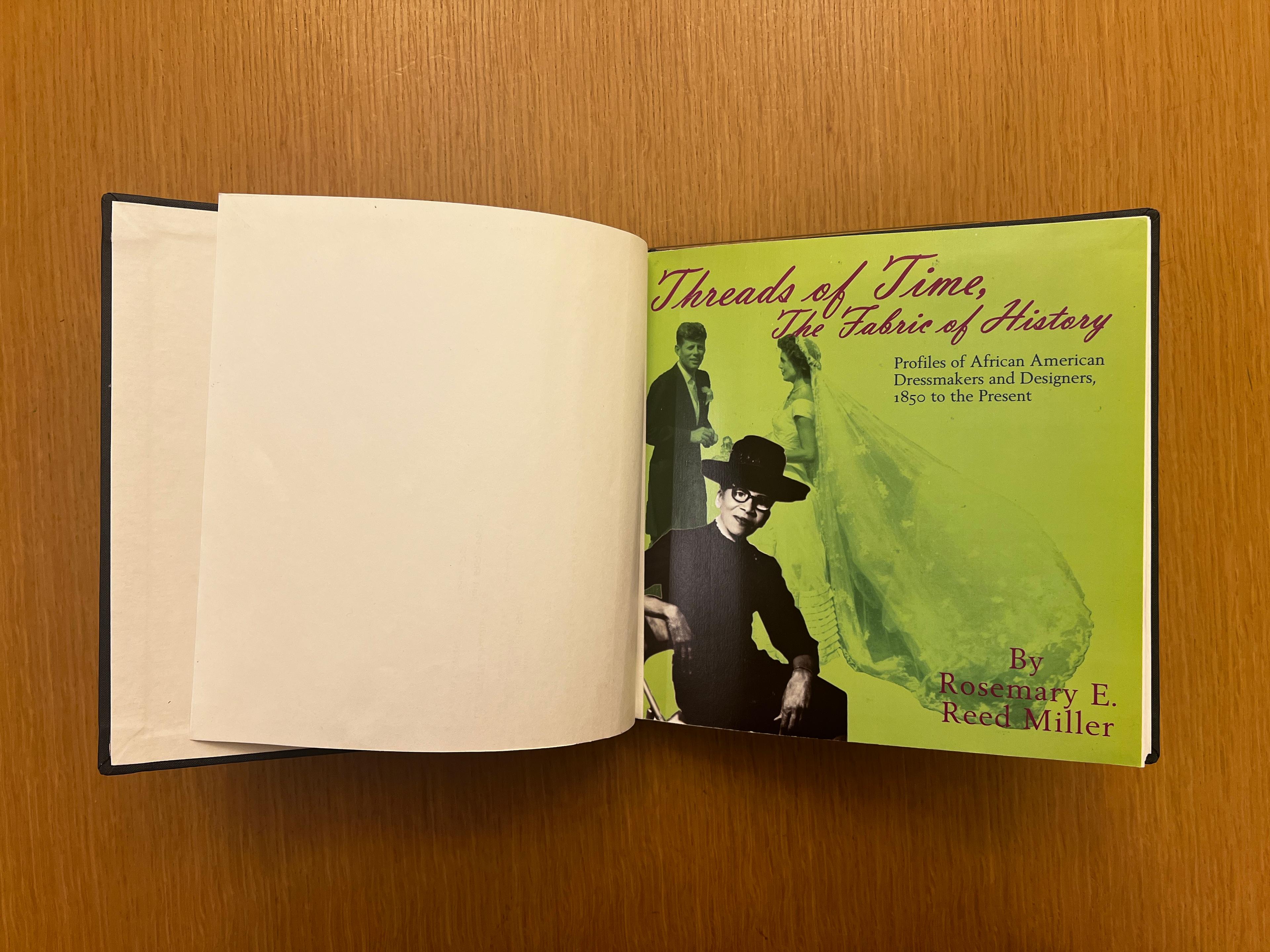
Reed Miller, Rosemary E. Threads of Time, The Fabric of History: Profiles of African American Dressmakers, 1850 to Present (Washington D.C.: Toast & Strawberries, 2002)
As a first-generation Vietnamese American, I am especially excited to acquire the work of creatives who share my background. Each discovery reminds me of how important it is for me to feel seen and represented. While scholarship on the history of Vietnamese fashion remains limited in scope in our holdings, we have been steadily expanding this area with intriguing reference materials and even fashion ephemera.
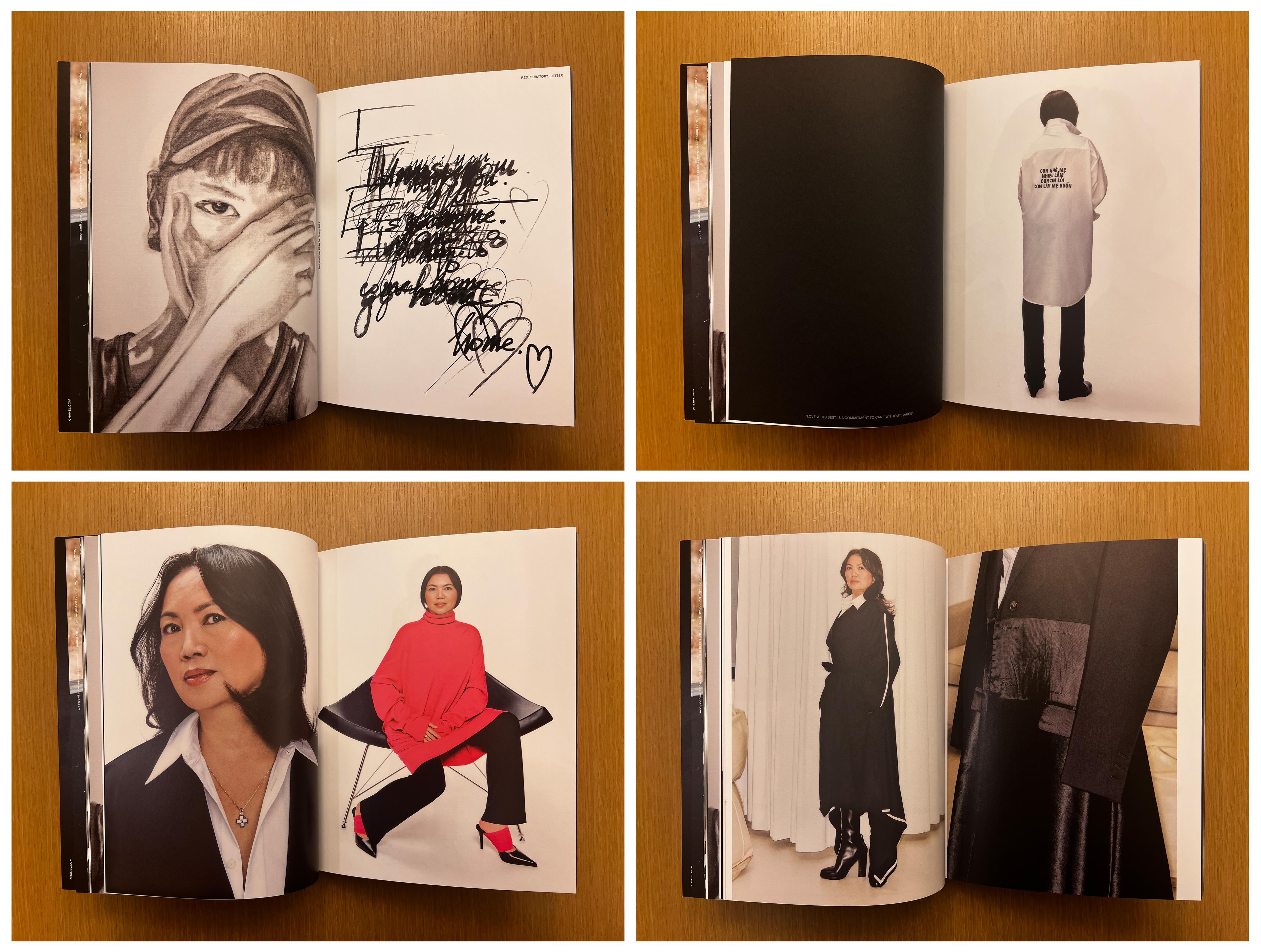
A Magazine (v. 26 2023) curated by guest editor Peter Do.
For the twenty-sixth issue of A Magazine (2023), which features a different guest editor for each issue, the curator was Peter Do, a young Vietnamese American fashion designer known for his highly refined and innovative approach to tailoring, as well as his effortlessly cool downtown aesthetic. After studying at the Fashion Institute of Technology, winning the inaugural LVMH Graduate Prize in 2014, and honing his craft at major design houses like Céline and Derek Lam, Do launched his eponymous label in 2018. He quickly gained attention for his fresh perspective, building a cult following on Instagram before emerging as a breakout star in the fashion world.
In this issue, Do focuses on the concept of “home,” exploring its unique duality for him since he was born in Biên Hòa, Vietnam, and immigrated to the United States with his parents at the age of fourteen. He takes readers back to his childhood home, showcasing his designs through gorgeous photo shoots. My favorite editorial is photographed by Huy Luong and features Do's mother wearing his creations. Vietnamese American poet Ocean Vuong captured the sentiment I felt perfectly when he wrote, “It is near impossible, as a Vietnamese son myself, not to look at these photos of Peter's mother, dressed immaculately in his garments, and not feel a collective pride that extends toward our own mothers. That in seeing Hồng wear her son's art on her body, we are seeing our own aunts, nieces, grandmas, and mothers wear them too.”

Souvenir from Peter Do for Helmut Lang Spring/Summer 2024 Debut Collection, in collaboration with Ocean Vuong.
At The Costume Institute Library, we’re always adding to our collection—mainly through purchases, but often thanks to the incredible generosity of our donors. One recent and very special addition comes from Eva Chen, Head of Fashion at Meta and a longtime Friend of The Costume Institute, who donated her personal collection of fashion invitations and ephemera. Among these special gifts is a rare collectible from Peter Do’s debut collection for Helmut Lang Spring/Summer 2024. Tucked inside a sleek plastic wallet is a silk scarf printed with a self-portrait by Ocean Vuong, who also contributed words and visuals for the show. These elegantly curated souvenirs were thoughtfully placed on attendees’ seats at the fashion show. We’re lucky to have not one but two of these in our library. The other came to us from writer Mary H.K. Choi. One copy will be preserved exactly as it was displayed at the show, while the other has been carefully separated so that each component—wallet, scarf, and printed materials—can be stored and accessed individually. This ephemera holds a significant moment in fashion history—one that celebrates Peter Do as one of the first well-established Vietnamese American designers bringing greater visibility to Asian American voices in high fashion.
Another treasured item in our collection is a pocket-sized risograph-printed artist’s book, Nguyễn Thị 4EVA (2024). Produced in a limited edition of one hundred copies, this interactive, interchangeable book both complements and amplifies its themes in playful and intimate ways. Created by two Vietnamese artists, Keith Khanh Truong and Quin Quynh Luong—both navigating life in America—the book merges the nostalgic charm of a dress-up game with the personal touch of a diary exchange between close friends. Its mix-and-match flipbook format presents thoughtfully styled ensembles that celebrate the beauty, joy, and resilience of their queer-trans Vietnamese identities.
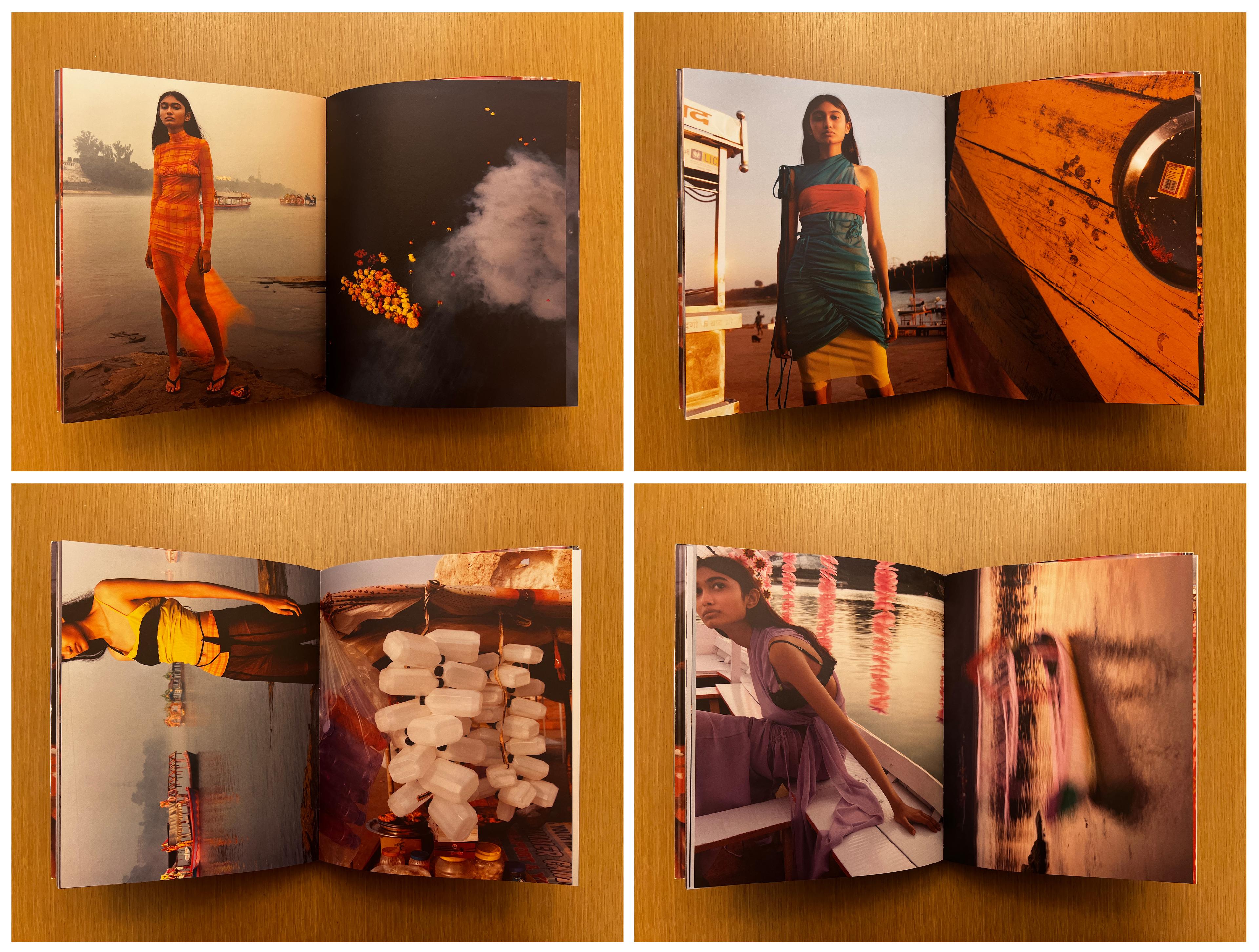
Lele, Supriya. Narmada ([London]: Jonny Lu Studio [2020])
Supriya Lele is a British-Indian fashion designer renowned for blending her South Asian heritage with contemporary Western sensibilities. Her collections often explore themes of identity, femininity, and cultural duality, reflecting her journey as a diasporic individual. Since launching her eponymous label in 2016, Lele has garnered widespread acclaim for her thought-provoking approach to womenswear.
Lele’s self-published book Narmada (2020) is a visual celebration of her Indian roots, created in collaboration with British documentary photographer Jamie Hawkesworth. The book documents their journey along the Narmada River in Jabalpur, India, exploring themes of identity, displacement, and belonging. Featuring striking images of local youth, the beauty of life along the river, and gorgeous atmospheric, foggy landscapes, Narmada also highlights Lele’s 2020 Spring/Summer women’s collection. When it was released, all proceeds from the book benefited Girl Rising, a charity dedicated to empowering girls and challenging gender discrimination worldwide. We also have Lele’s lookbook zine for her Spring/Summer 2024 collection, photographed by Anders Edström and printed in a limited edition of two hundred fifty.

Left, Magugu, Thebe. Thebe Magugu: Ipopeng ext. "Anthro 1": An Exhibition of the Thebe Magugu A W 20 Collection ([Place of publication not identified] : Faculty Press in collaboration with The Rolling Thunder of Change, [2020]) ; Right, Magugu, Thebe. Thebe Magugu: "Doublethink" Spring/Summer '22 - menswear ([South Africa?] : Faculty Press, [2021])
Continuing this thread on global designers, Thebe Magugu is a South African fashion designer known for mixing traditional African elements with modern high-fashion. His self-named label, which launched in 2015, gained international acclaim for his distinctive approach to fashion. Rooted in narrative and functionality, his clothing is as much about storytelling as it is about wearability. Magugu became the first African designer to win the prestigious LVMH Prize for Young Fashion Designers in 2019, solidifying his place as a trailblazer in the global fashion scene. In 2021, Magugu was interviewed by Associate Curator Mellissa Huber to discuss his work and the background details for a dress we acquired for The Costume Institute’s collection.
Magugu generously donated two of his publications to our library. Doublethink (2021) was created in collaboration with South Africa’s Daily Maverick, where Magugu worked with top journalists to produce a thirty-two page newsprint publication. Published by Faculty Press, also founded by Magugu, this limited-edition tabloid pairs his Spring/Summer 2022 menswear lookbook with investigative reporting and current events. The project was inspired by Magugu's discussions with journalist Mandy Wiener, exploring the links between government corruption and unemployment in South Africa.
Magugu's lookbook Ipopeng Ext. "Anthro 1" (2020) offers a glimpse into the autobiographical influences behind his Autumn/Winter 2020–21 collection. Designed in the style of a library-bound book, it features spine labels indicating the year of the collection, mimicking the format of a call number. This book is also named after the suburb of Ipopeng in Kimberley, South Africa, where Magugu grew up. It explores the significance of his hometown and the people who shaped his worldview, particularly the women in his life. The epilogue, reflecting on the death of his grandmother, Matiego Magugu, serves as a poignant tribute to his family and community's powerful role in his journey as a designer.
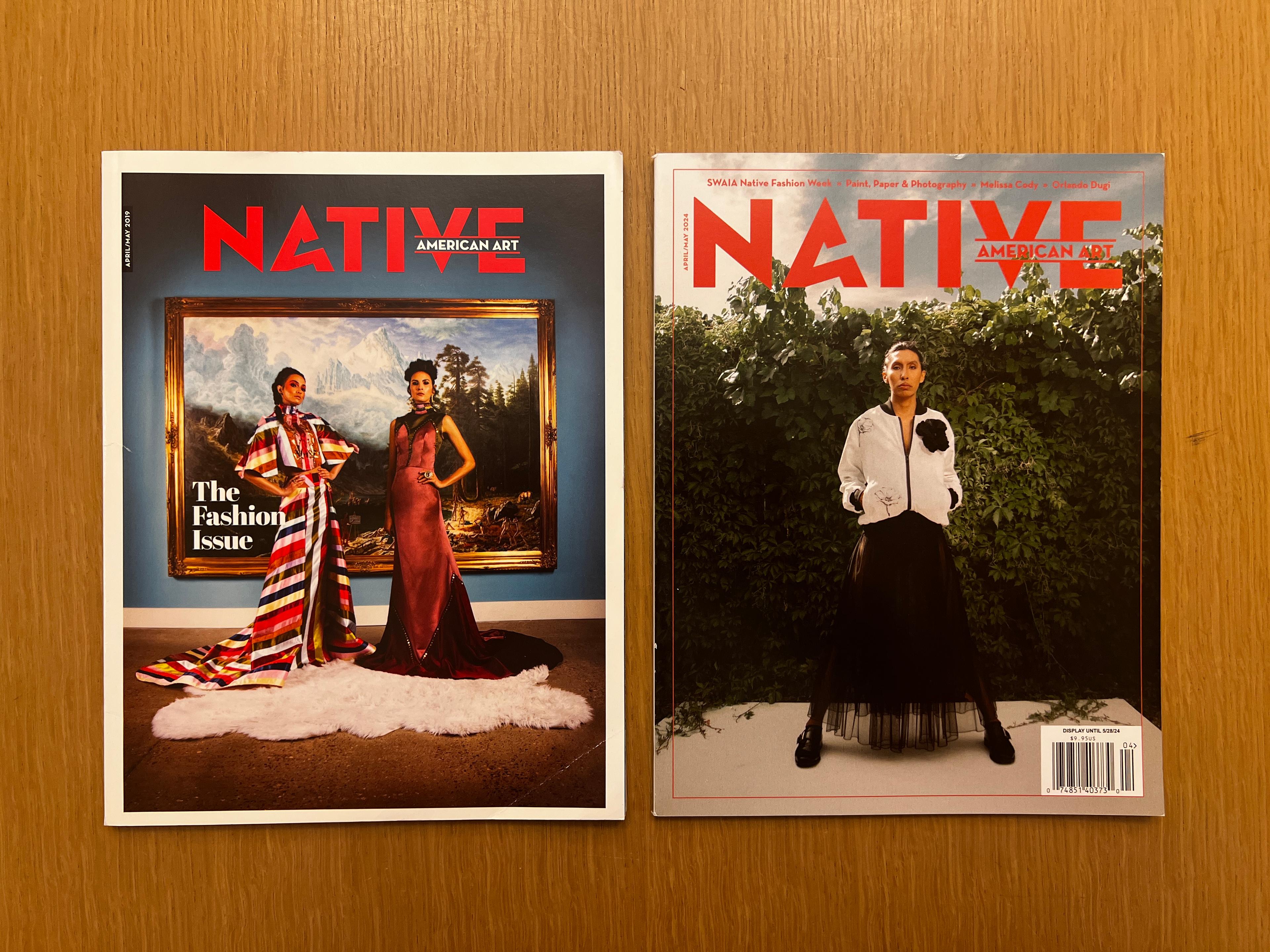
Fashion-themed issues of Native American Art magazines
In addition to our broader fashion collection of books, we collect niche runs of magazines, including fashion- and clothing-themed issues of Native American Art magazine. One standout issue features models Angelica Padilla (left) and Mona Bea (right), wearing dresses by Jamie Okuma (who was featured in our past Costume Institute exhibit In America: A Lexicon of Fashion in 2021), set against a painting by Kent Monkman, whose massive paintings were the inaugural Great Hall Commission at The Met in 2019. Styled by Amber-Dawn Bear Robe and photographed by Cara Romero, this issue beautifully highlights the intersection of fashion, Indigenous culture, and art.
Another key addition to our collection is Fashioning the Self in Slavery and Freedom, a special-interest publication by our former fellow, Dr. Jonathan M. Square. This thought-provoking work explores the intersection of slavery and fashion, contributing to a larger digital-humanities project centered on race, identity, and equity. Square served on the advisory committee for the current Costume Institute exhibition Superfine: Tailoring Black Style.
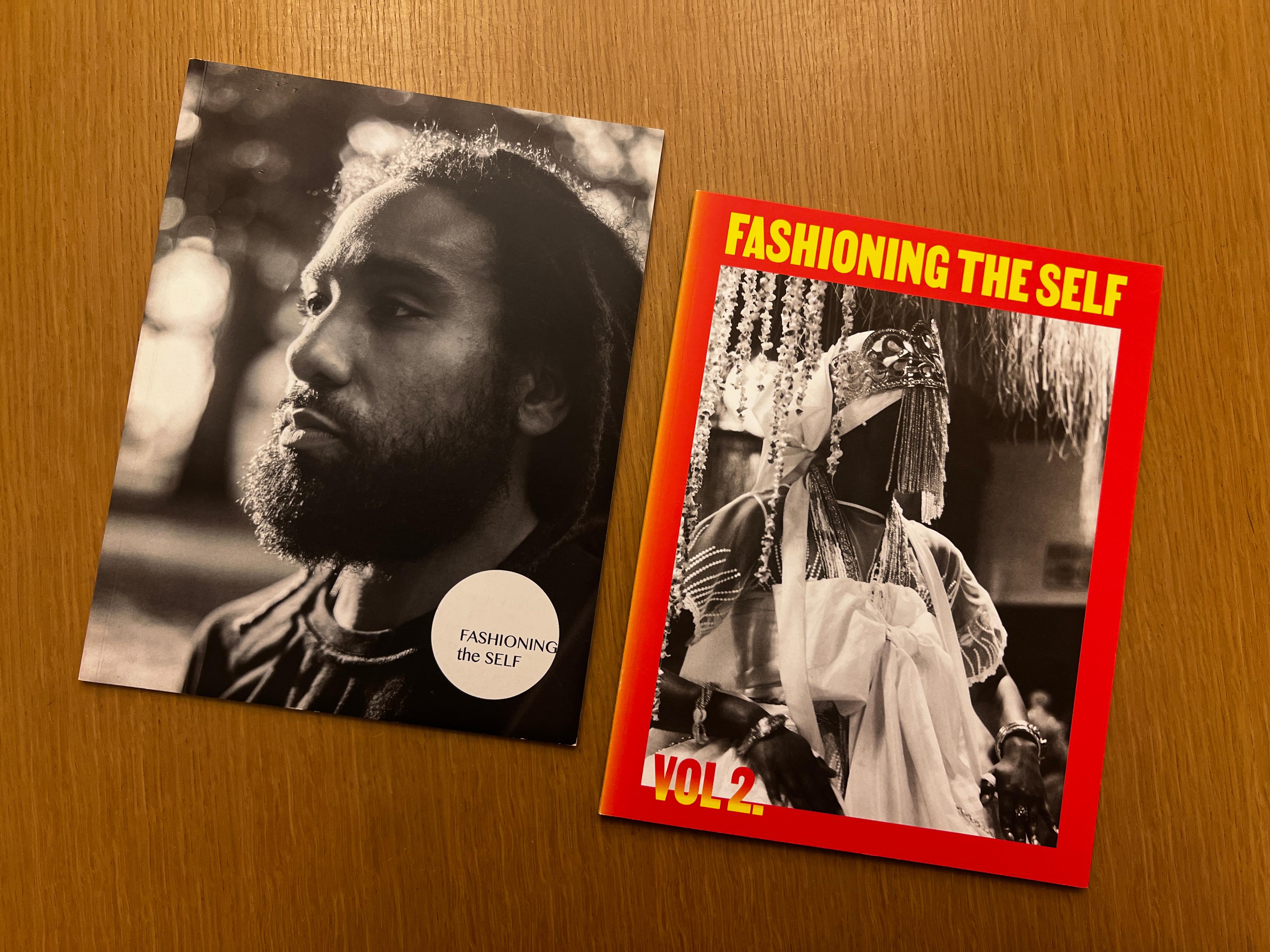
Volumes 1 and 2 of Fashioning the Self
Some of my favorite reference materials to collect are street style publications, capturing the unique ways in which everyday people express themselves through fashion. Frutas magazine is an unapologetic celebration of Los Angeles's vibrant and diverse subcultures. Focusing on Latino and Chicano culture, it showcases the dynamic street style of the city through the lens of photographer and multimedia artist Bibs Moreno. Launched in 2021, the magazine draws inspiration from the iconic Japanese street style publication Fruits, photographed by Shoichi Aoki, which blended striking aesthetics, eccentric fashion, and a bold approach to identity. Frutas started as a community-based platform, documenting connections from friends to friends of friends to people at parties. It now serves as an archive of a world where diverse subcultures converge and intertwine, capturing the dynamic fusion of LA's multicultural energy. In Moreno’s words, “We should be documenting this and archiving this because we’re contributing to these really cool flourishing communities, and people don’t know about it. And if you don’t document it, it’s gonna be lost to nothingness until someone comes along to gather all that and prove that it existed.”
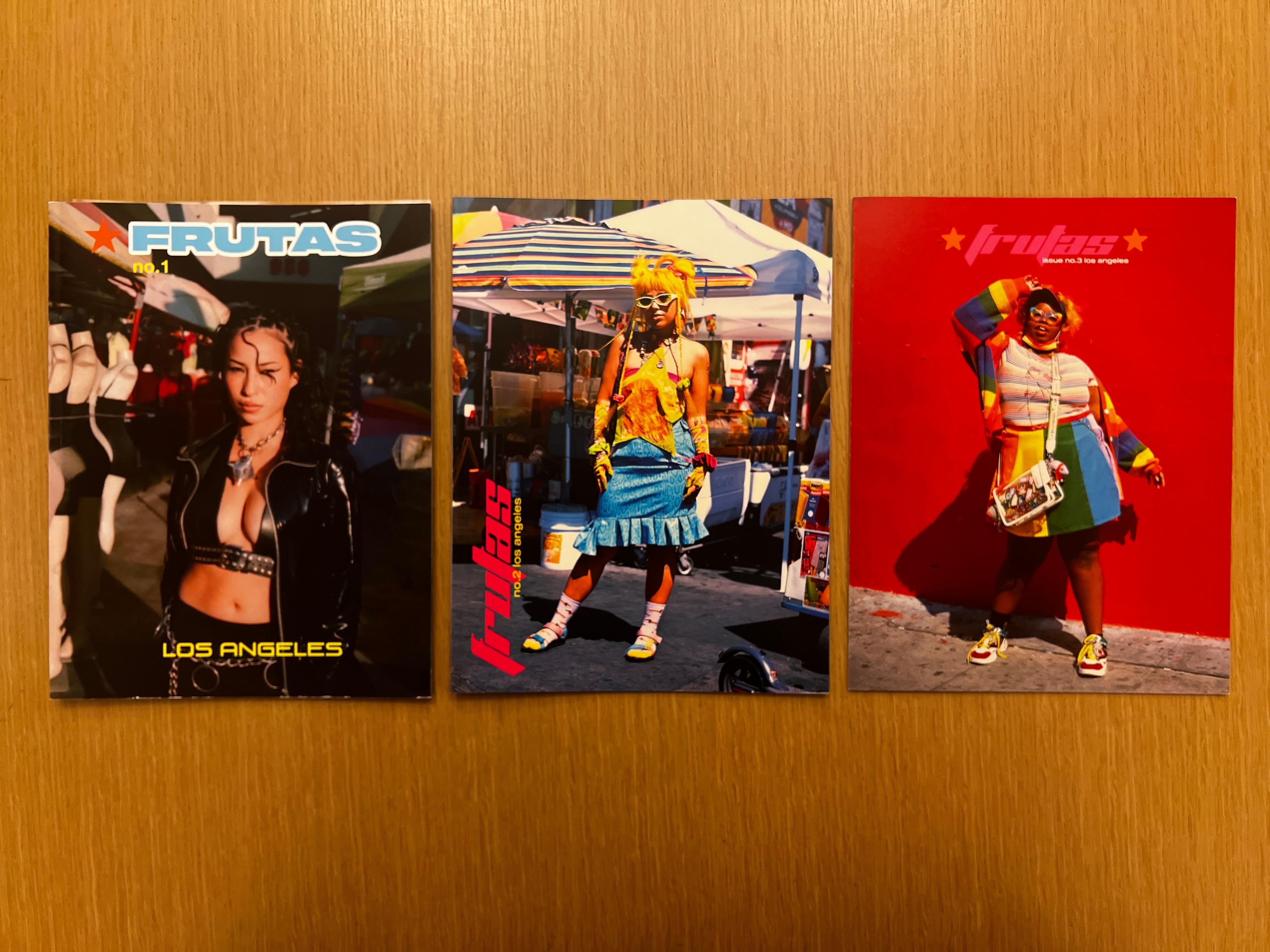
The first three issues of Frutas magazine
LV2, "Virgil," NIGO (2020) photographed by Nick Haymes, is a limited-edition zine celebrating the collaboration between the late Virgil Abloh and Nigo, two visionary designers united by a longstanding friendship, for a one-off Louis Vuitton collection called LV2. Documenting the journey from the duo’s initial meetings in Tokyo to the final realization of the collection in Paris, this zine captures the essence of their collaboration. Printed in Japan using Fuji Xerox Iridesse technology, it features high-quality production with gold, silver, and CMYK detailing. It is best viewed in person due to the way the colors and textures of the paper change at different angles, making it a fitting tribute to this unique partnership.
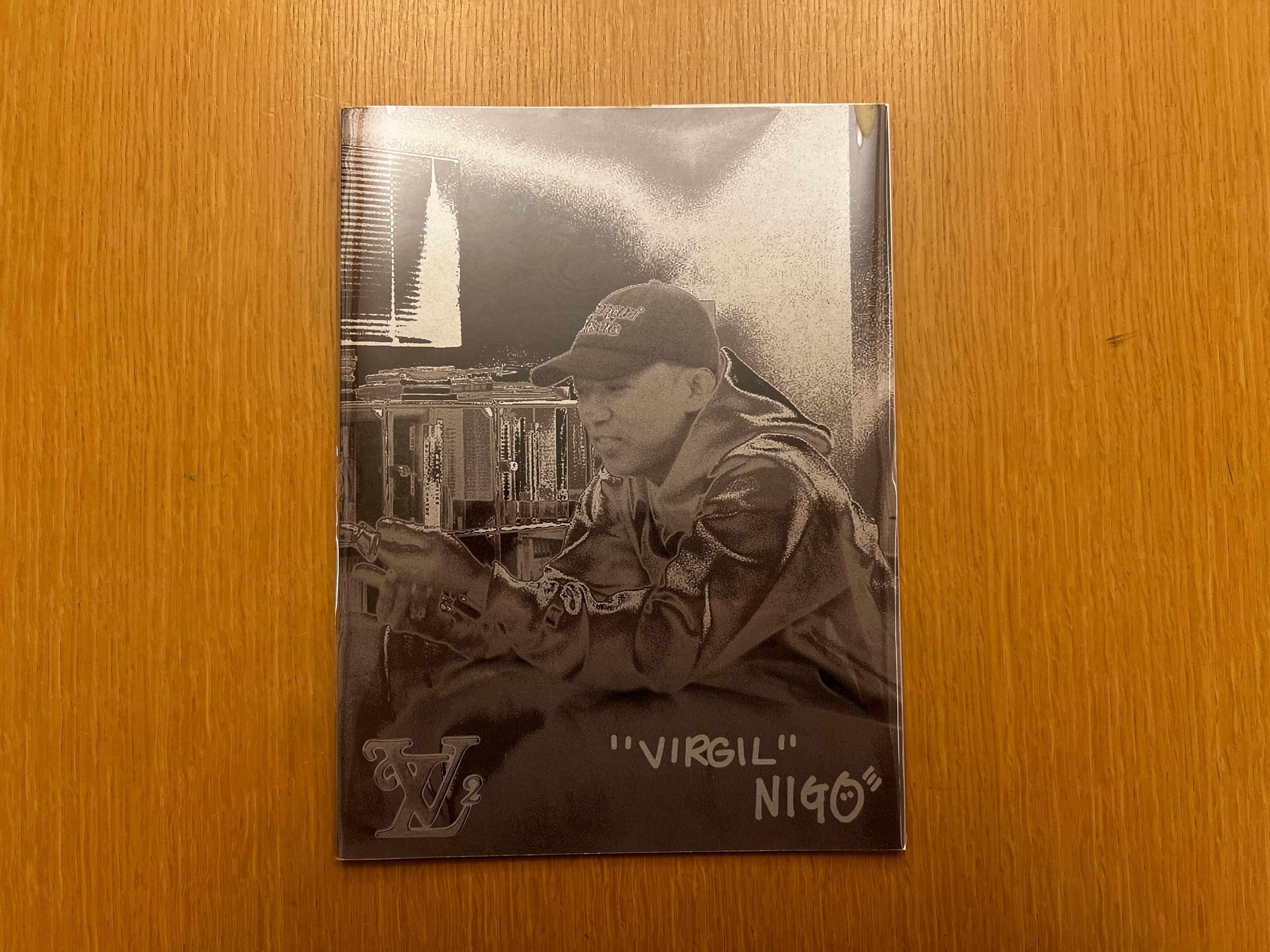
Haymes, Nick. LV2, "Virgil," NIGO ([Japan]: Fuji Xerox Iridesse Production Press, [2020])
KH is an under-the-radar gem that showcases the work of Brooklyn-based photographer Kevin Harry, celebrating Black culture and style across all five boroughs of New York City. The majority of the photos are taken at local festivals and parades, all capturing the incredible style and flair of individuals often overlooked by mainstream fashion publications. We’re fortunate to have every issue of this unique magazine to date. Harry captures his subjects' joy, pride, and rebellious spirit through his lens, creating a record that offers an intimate view of tight-knit communities and individual expression. Street style magazines like KH, along with others mentioned here, are a powerful source of inspiration for designers, stylists, and anyone passionate about fashion.
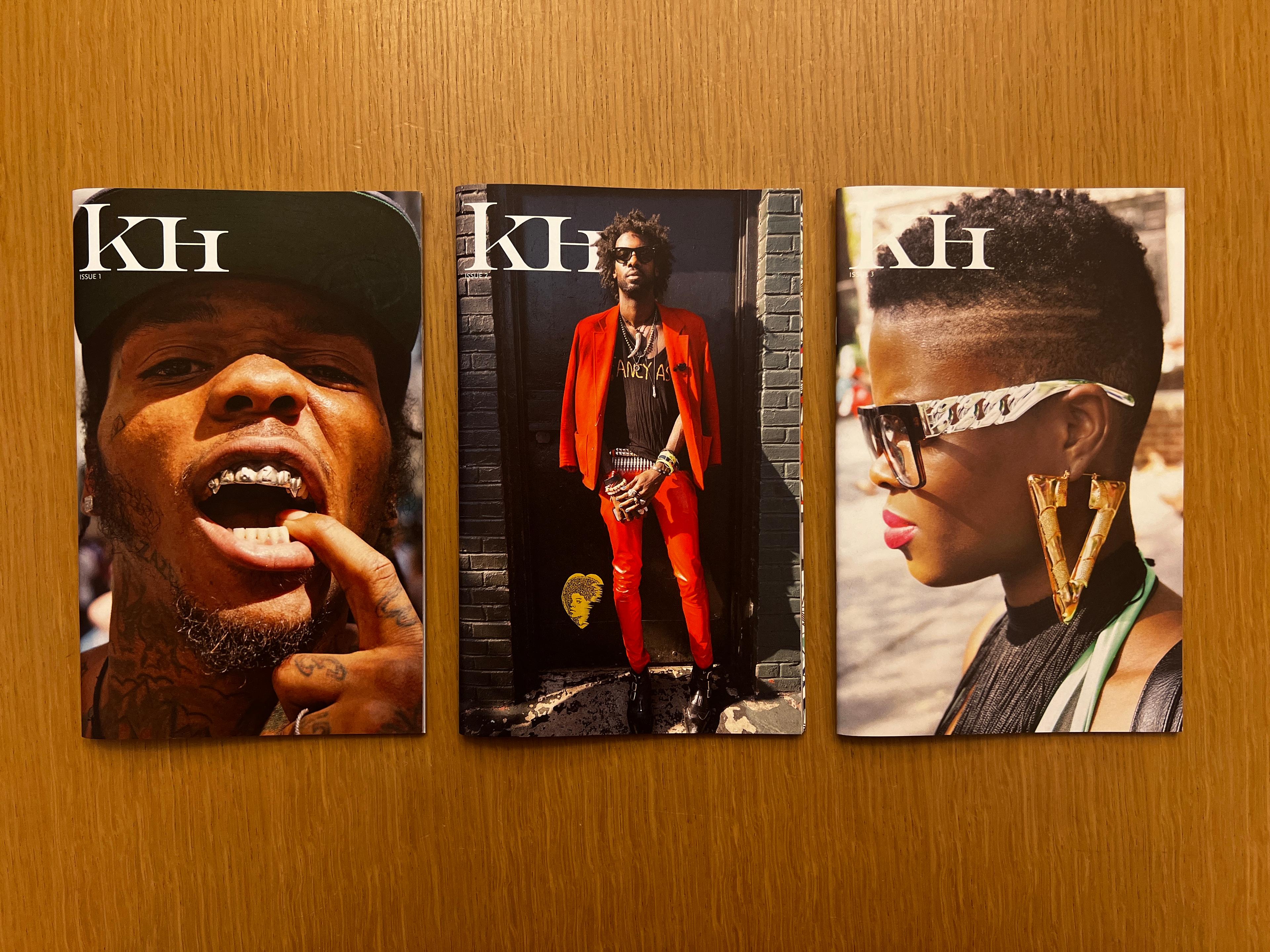
The first three issues of KH
A continued commitment to diversity and representation
In collaboration with our colleagues at Watson Library, we recently contributed over sixty fashion-related names, from designers to photographers, to the Index of Black Artists of North America, a resource highlighting Black artists connected to the United States, Canada, Mexico, and the Caribbean. We are excited to continue adding more BIPOC fashion voices to the library’s other artist indexes in the future, including those for Asian American, Pacific Islander, Indigenous, Native American, Latine, Hispanic, and LGBTQIA+ artists.
For those engaged in fashion scholarship, we welcome and encourage recommendations for additional research tools and related collections at other institutions. Recently, the New York Public Library’s Schomburg Center for Research in Black Culture released a fashion research guide, adding another invaluable resource to this field of study. Special thanks to the ARLIS/NA Special Interest Group for Fashion, Textile, and Costume for their ongoing efforts to enhance resource sharing among professionals working with specialized library collections.
At the heart of all our library acquisitions and initiatives is a consistent goal: to make the diverse and often overlooked stories of fashion history accessible to all. By thoughtfully collecting materials highlighting underrepresented voices, we hope to foster a more inclusive and equitable space for future scholarship. While our work is ongoing, we remain committed to expanding The Costume Institute Library collection to reflect the voices of those who have shaped—and continue to shape—the ever-evolving landscape of fashion. Whether through rare books, independent magazines, or unique book projects by artists and designers, we aim to build a fashion library collection that authentically represents the rich diversity of the global creative community.
To explore our holdings further, do a keyword search for “Fashion DEIA” in Watsonline. Materials from our fashion library collection can be requested and viewed in Watson Library. Please check our website for additional information about The Costume Institute’s Irene Lewisohn Costume Reference Library, archives, and special collections. For more updates on new acquisitions and more examples of what is inside our fashion library collection and department, please follow us on Instagram at @costumeinstitutelibrary and @metcostumeinstitute.
